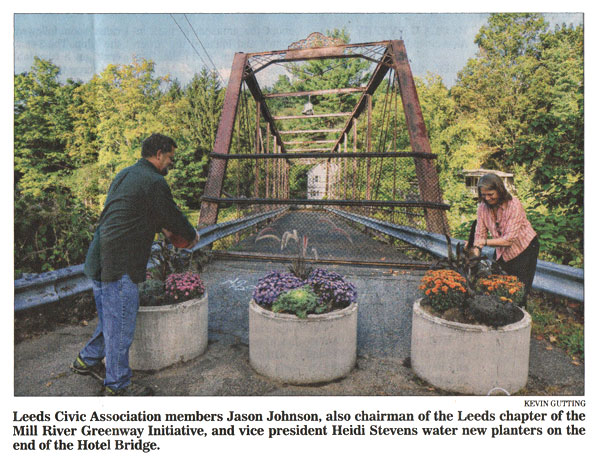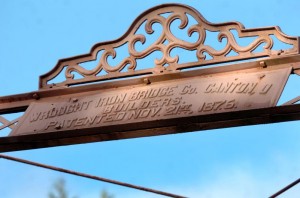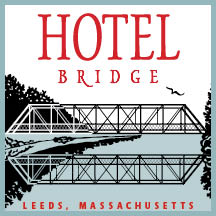Leeds group makes push to preserve beloved Hotel Bridge
From The Daily Hampshire Gazette article September 16, 2014
By Chad Cain
Staff Writer
Tuesday, September 16, 2014
 NORTHAMPTON — As a special police officer for Northampton nearly five decades ago, Chuck Dunning had frequent occasion to cross the iconic Hotel Bridge as part of his job walking the beat in Leeds.
NORTHAMPTON — As a special police officer for Northampton nearly five decades ago, Chuck Dunning had frequent occasion to cross the iconic Hotel Bridge as part of his job walking the beat in Leeds.
He remembers lingering on the bridge during those walks like it was yesterday.
“In the summer time, it was always a pleasure to cross the iron bridge, stopping and admiring the scenery,” Dunning said by email from his home in Florida. “Strange. I’m now 81 and it was like yesterday that I can remember walking over the bridge. It holds great memories, as the entire village of Leeds does.”
So when Dunning heard about a fledgling effort spearheaded by the Leeds Civic Association to save the dilapidated bridge spanning the Mill River between Water and Main streets, he fired off an email offering to donate to the project.
He’s not the only one waxing nostalgic, said Heidi Stevens, the association’s vice president. “We’ve been getting emails like this from a lot of people sharing their memories about the bridge,” she said.
 That’s partly why a group of Leeds residents led by the civic association is reviving a long-desired effort to raise money to restore and preserve the bridge for pedestrian use. The effort is taking on renewed significance this summer now that the bridge is on its last legs and in recent weeks has been permanently blocked off to walkers and bicyclists.
That’s partly why a group of Leeds residents led by the civic association is reviving a long-desired effort to raise money to restore and preserve the bridge for pedestrian use. The effort is taking on renewed significance this summer now that the bridge is on its last legs and in recent weeks has been permanently blocked off to walkers and bicyclists.
“It really is a beloved bridge here in Leeds,” Ward 7 City Councilor Alisa F. Klein said. “It has this incredible history.”
The single-lane iron truss bridge, constructed in 1880, was named after the Leeds Hotel, which was built next to it in 1885 to accommodate the village’s growing population. The historic structure is also known as Old Shepherd Road Bridge.
Over the years, the bridge became a key passage over the Mill River, first for stagecoaches and later for vehicles that served the manufacturing hub. And in more recent times, the bridge has been a popular pedestrian and bicycle way for people wanting to visit the Roberts Hill Conservation Area, Musante Beach, and the post office, among other sites.
In addition to being the oldest bridge in Northampton, the Hotel Bridge is the sixth-oldest iron bridge in the state.
“The bridge represents the heart of our community,” said Jason Johnson, chairman of the Leeds chapter of the Mill River Greenway Initiative. “The bridge is really this vital artery of transportation for a lot of members of the town.”
Fenced off
The Mill River Greenway is backing efforts to preserve the bridge as part of its overall mission to design a greenway that connects people to the river.
The bridge has been closed to vehicles since 2004 when the city installed Jersey barriers on each end. Pedestrians and bicyclists continued to cross the bridge over the last decade, despite signs warning against it. That changed about a month ago when the Department of Public Works installed a chain-link fence on both sides of the bridge to keep people off it for good.
DPW Director Edward S. Huntley said the corrugated metal decking of the deck has missing pieces and there are holes in the pavement. “Basically, someone could get really hurt up there,” he said. “You can see the water through the bridge.”
The decision to fence off the bridge was made because of findings of a recently completed engineering study that analyzed its structural integrity and pinpointed weaknesses in certain beams, among other problems. The $35,000 study completed by Stantec Consulting Service Inc. of Northampton was financed by a Community Preservation Act grant awarded last year to the DPW at the behest of the civic association.
“The impetus here is, we were still using the bridge up until last month,” said Susan Carbin, civic association president. “Now everybody is feeling the pinch.”
Carbin said people are longing to use the bridge again, which she said is “absolutely part of Leeds” and historically significant to all of Northampton.
The Stantec study pegged the bridge repairs at $1.5 million, although civic association members believe they will not need to spend near that amount to address safety issues. Carbin pointed out that $650,000 of that estimate is for painting alone, a feature that is not vital to safety.
The group intends to enlist the help of Alan Lutenegger, a professor of civil and environmental engineering at the University of Massachusetts Amherst, and engineers who live in Leeds and want to help with the project, Stevens said.
Lutenegger said Monday that preserving these kinds of structures is an important way to understand a society’s heritage, especially in terms of engineering. While some bridges are preserved for vehicle traffic, he said, it’s just as useful to try to save them for pedestrian use.
“It’s a great learning tool for students at all levels,” he said. “To see where you’re going in the future, you need to look at where you’ve been in the past. That’s certainly true in all types of engineering.”
Historic designation
While various fundraisers have taken place over the last several years in an effort to raise money to fix the bridge, including an annual bike ride, the renewed effort by the civic association will involve a more elaborate strategy.
“The Leeds Civic Association and volunteers want to raise awareness in Leeds and throughout Northampton about the value of this bridge to the city and to the state,” Stevens said.
The civic association, with the support of the Board of Public Works and the City Council, intends to submit an application in the coming months to the Massachusetts Historical Commission seeking to have the bridge certified as an historic structure. That designation will then allow the group to apply for federal grants from the National Register of Historic Places to help pay for the repairs.
Klein said these types of iron truss bridges were only constructed for a short period of time in the late 19th and early 20th centuries, and about half of the bridges constructed have been lost over the last two decades. A renewed push at the federal level to save historic bridges is now underway, she said.
“There is a feeling among preservationists that we are losing key pieces of our history,” Klein said. “Preservation of historical bridges is one of the key goals for the U.S. at the federal level.”
She said the group has no intention of asking the city to use capital money for the project.
The goal is to have the bridge repaired and reopened for foot traffic, Stevens said.
While the fundraising effort is in its early stages, Stevens said in the meantime the civic association is doing what it can to beautify the area. DPW crews removed the Jersey barriers late last week and replaced them with cement planters purchased by the association. Those planters have since been filled with flowers.
In a related project, Huntley said engineering students from Smith College will study the possibility of creating a spur from the Norwottuck Rail Trail to the bridge.
In addition to its historical significance as an engineering and architectural structure, a restored bridge that’s linked to the bike path could have a positive economic impact for Leeds, Stevens believes. She said a community in Simsbury, Connecticut, that restored a similar bridge now rents it out for community events, weddings and more. The bridge is decorated with flower baskets and is a popular walking spot, she said.
“It is something that has really unified a lot of people in Leeds,” Klein said. “Everybody has a story about the bridge. It really is held in the hearts of Leeds.”
Chad Cain can be reached at ccain@gazettenet.com.


